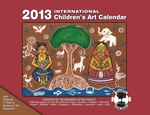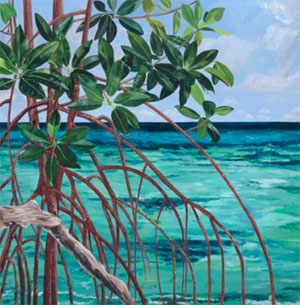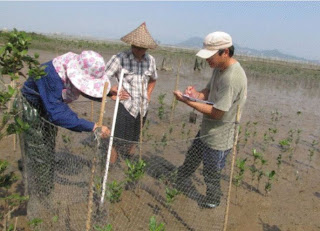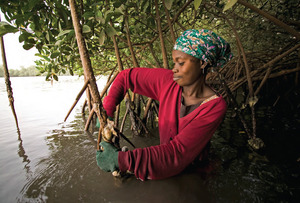Action Alerts:
Want to Make A Change? – Immediate Internship Opportunity CLICK HERE
Phulbari Coal Mine Blog – View Blog
Help save the Balikpapan Bay are: home of one of the largest populations of proboscis monkeys and one of the first orangutan release sites – Sungai Wain Protection Forest! Sign the petition MAP's 2013 Children's Mangrove Art Calendars are now available! 
Calendar offer $12 plus $2 shipping in US and $12 plus $4 shipping for intl. purchases. ORDER HERE
MAP's 2014 Children's Mangrove Art Calendar sponsors needed. View PDF Support MAP Through Art Support MAP through Art!

Enma Saiz has released only 50 signed reproductions. Read More Donate to MAP via Paypal
Giving could never be easier Green Planet Fundraising Assists MAP – LEARN MORE
URGENT – VOLUNTEERS NEEDED! MAP is looking for volunteer interns for its Thailand Headquarters – READ MORE MAP’s VOLUNTEER INTERNS HELP MAP MAKE A BIG DIFFERENCE
READ MORE
MANGROVE ISSUES MANGROVE BOOK – J. Primavera
The book Beach Forests and Mangrove Associates in the Philippines by J.H. Pimavera and R.B. Sadaba (ISBN 978-971-9931-01-0; National Library CIP QK938.C6 581.75109599 2012 P220120602) is now available. aves, flowers, fruits, utilization and silviculture.
SEE POSTER and order instructions View MAP’s uploaded Videos at MAPmangrover’sChannel “Education In The Mangroves" can now be seen on the PhotoPhilanthropy website here! Marvellous Mangroves – A Curriculum-Based Teachers Guide.
By Martin A. Keeley, Education Director, Mangrove Action Project
Read this 10 page history of the development of MAP’s educational curriculum VIEW DOCUMENT FOR MORE ON MAPs AWARD WINNING CHINA MANGROVE CURRICULUM VISIT THESE SIGHTS
SLIDE SHOW VIMEO SHOW Education In The Mangroves
Six minute video features discussion of Mangrove Action Project’s Mangrove Curriculum VIEW THE VIDEO
Article in Canada's Green Teacher Magazine – Read More
"Question Your Shrimp" Campaign Learn more about the affects of the shrimp industry on mangroves by visiting our blog Editor’s Note: Mangrove Action Project’s Executive Director, Alfrodo Quarto was interviewed about shrimp by Green Acre Radio’s Martha Baskin LISTEN TO INTERVIEW
Join MAP on Facebook
Sign the Consumer's Pledge to avoid imported shrimp

Not yet a MAP News subscriber?
Click here to subscribe.
Note to Our Readers:
We strive to keep active links in our newsletter. However, due to circumstances beyond our control, occassionally links to stories may become broken. If you find a link to a story is not functioning, please cut and paste the headline into your browser search bar. In most cases you should be able to locate the original story.
 Help Mangrove Action Project through your recycled E-Waste. List of Accepted E-waste Items: Injet Cartidges, Cell Phones, Pagers, GPS, Radar Detectors, Mobile Hot Spots, Calculators, eBook Readers, iPods/MP3 players, Digital/Video Cameras/Camcorders, PDAs, iPads/Tablets/Laptops, Video Game Consoles, Handheld Video Games Visit the Mangrove Action Project recycle website Click on the recycle button then click on the Download Shipping Label, and follow the instructions.  | FEATURED STORY Mangrove Planting Research at Eyuyu Island, Fujian Province  CHINA – China Mangrove Conservation Network (CMCN) is a non-governmental organization which devotes itself to mangrove protection. Founded in 2001, CMCN has successfully united various forces – mangrove reserves, communities, schools, volunteer groups, NGOs, relative government agencies and mass media – as a network. Since 2003 CMCN started the mangrove restoration project and relevant basic scientific research programs. So far CMCN has organized or participated in planting activities hundreds of times and has planted more than 900,000 seedlings. During the process of mangrove restoration, CMCN has overcome many technical problems including tree species selection, management and cultivation. Summarizing the experience over the past ten years, CMCN has published a mangrove restoration instruction manual for public participants. However, there are still many challenges confronting mangrove restoration. READ MORE AFRICA Mangroves in UAE: A Unique Marine Ecosystem  UAE – The mangrove forests that cover thousands of hectares of land along the UAE shoreline form an integral part of the coastal ecosystem in the UAE. They provide a rich natural habitat and safe breeding grounds for several fish species, sea snakes, turtles and commercially important shrimp, snapper, grunt fish and sea bream. In fact, mangroves are natural habitats for 75% of all tropical juvenile commercial fish species in the world. Sea birds also find safe nesting and egg laying areas in the vast mangrove forests of the country. READ MORE Al Gharbia initiative to preserve mangroves UAE – An initiative to plant 10,000 mangrove saplings has been launched by the Western Region Development Council (WRDC) in Al Gharbia, or the Western Region of Abu Dhabi. The saplings are to be planted along the coast of Al Mirfa, which is already home to mangrove forests and is considered to be one of the areas in the emirate best suited for such afforestation initiatives. The initiative brings together the Western Region Development Council and Environment Agency-Abu Dhabi (EAD) in a partnership. A similar programme was implemented in 2011 by the WRDC to conserve the mangroves. Mangroves comprise a class of trees that grow in low-salinity water. Such vegetation provides a natural habitat for the breeding of many fish species, sea snakes, turtles and other marine creatures. VIEW SOURCE Forest negotiations get stuck at climate talk QATAR – Focus on the actions needed to reduce deforestation, not on complicated measurement and verification processes, urges the Accra Caucus. A bid to secure a deal to save the worlds remaining forests has stalled, on the issues of monitoring emissions and the lack of secure funding , says the Accra Caucus coalition of groups tracking the UN negotiations in Doha. The scheme known as REDD+, (reducing emissions from deforestation and forest degradation), calls on wealthier countries to pay developing countries to keep their forests standing as way of combating climate change. Many of these forested countries have already started putting into place strategies to tackle deforestation, yet if funding dries up, the entire programme could be derailed. READ MORE ASIA Indian children wish for a greener future  One-third of children across the globe are concerned about pollution, and over a quarter of children in India want to participate in afforestation activities, a global survey on children's hopes, aspirations and fears revealed recently. The Small Voices, Big Dreams survey revealed 27 percent of Indian children, more than the global average of 22 percent, want to contribute to environment by planting more saplings, ChildFund India, part of the NGO ChildFund International, said in a statement. It showed 21 percent of Indian children worried most about lack of sanitation, followed by pollution (17 percent), lack of drinking water (14 percent) and deforestation (11 percent). READ MORE Phulbari Coal Mine News Updates  BAGLADESH – In the Phulbari area of Northwest Bangladesh, communities have come together to raise their voices against the proposed Phulbari Coal Project–which threatens to turn this fertile agricultural region into an open-pit coal mine. If implemented, the mine would have devastating environmental impacts and ultimately displace up to 220,000 people. READ MORE Indonesia banks on aquaculture for growth INDONESIA – Indonesia will pursue aquaculture development in order to increase fish exports, a minister said. Maritime Affairs and Fisheries Minister Sharif C. Sutardjo said that aquaculture is a viable solution to boost revenue amid decreasing populations in the world’s oceans. In Indonesia, the quota for commercial fishing is five million tons a year out of a population of six million tons of fish. Meanwhile, aquaculture production reached 7.9 million tons in 2011 with an estimated potential of 40 million tons a year. Sharif said that aquaculture is predictable, thus making it more attractive than commercial fishing. “Aquaculture will spearhead the ministry [program] in the future. There are plenty of available lands and shallow water that can be utilized for aquaculture,” he said. READ MORE Aogu Wetland Forest Park opens in Chiayi County

TAIWAN – Aogu Wetland Forest Park, a 1,470-hectare site in Chiayi County’s Dongshi Township in southwestern Taiwan, opened Nov. 24. “Wetlands are the lungs and kidneys of the Earth,” ROC Premier Sean C. Chen said at the opening ceremony. “They are crucial to regulating the environment, so must be protected and put to wise use.” Taiwan will soon have more such reserves, Chen said. A wetlands protection bill drawn up by the Ministry of the Interior and reviewed three times by ministers without portfolio is set to be sent to the Cabinet next week, he added. READ MORE
India disputes Japan's shrimp standards
INDIA – India has raised with the World Trade Organization what it calls “unscientific and unjustified” health standards imposed by Japan on its shrimp exports. The move comes as more than 140 containers of frozen Indian shrimps await clearance at Japanese ports. Japan, which has recently lowered the acceptable level of ethoxyquin in shrimps, has since August rejected seven Indian consignments of the seafood. Ethoxyquin is an anti-oxidant widely used in shrimp feed.
“We have raised the issue with the sanitary & phytosanitary committee of the WTO. We believe the new standards that have been imposed are unscientific and unjustified,” a commerce department official told ET.
According to industry estimates, export of shrimps from Odisha and West Bengal has fallen by up to 50 percent in the last four to five months due to the Japanese restrictions. In 2011-12, shrimps accounted for half of India's total seafood export of USD 3.5 billion.
READ MORE
AMERICAS
Restoring and Managing Mangrove Ecosystems in a changing world

GUYANA – The Guyana Mangrove Restoration Project (GMRP), the National Agriculture Research and Extension Institute (NAREI) and the University of Guyana (UG) have the pleasure to invite mangrove researchers, restoration practitioners and managers to participate in the 1st Guyana Mangrove Forum “Restoring and Managing Mangrove Ecosystems in a changing world” which will be held in Georgetown, Guyana, April 11-13, 2013. The Guyana Mangrove Forum is an important event of the Guyana Mangrove Restoration Project (GMRP), a project co-funded by the Government of Guyana and the European Union. The GMRP aims to respond to climate change and to mitigate its effects through the protection, rehabilitation and wise use of Guyana's mangrove ecosystems. The objective of the Guyana Mangrove Forum is to build local and regional capacity in mangrove restoration and management, continue to raise the public profile of the values of mangroves in Guyana and to bring together national, regional and international researchers to share experience and knowledge of the sustainable management of mangrove ecosystems. READ MORE
EUROPE
Securing the Future Of Mangroves

BELGIUM – The UN University Institute for Water, Environment and Health has published a policy brief titled “Securing the Future of Mangroves”. The brief is based on the World Atlas of Mangroves and describes both the current status of mangroves, including their economic value, as well as threats to mangrove ecosystems and considerations for good management practices. Continued loss of mangrove forests will have serious ecological and socio-economic impacts, especially on coastal communities that rely directly on mangrove products and services for their livelihoods. The effects of human activities on mangroves have far exceeded those of natural events over the past few decades. Economic development, rapid population growth and high population densities in coastal areas are the main drivers for mangrove degradation and loss. Although causes for loss can differ substantially amongst regions and countries, aquaculture has been the major global driver for mangrove conversion, and still represents one of the greatest global threats. Already the environmental toll on mangroves and other coastal ecosystems from aquaculture has been severe. READ MORE
LAST WORD What? No last word? Submit your comments for our next issue ~ If you’d like to have the last word on this or any other mangrove related topic, please send us your submission for upcoming newsletters. We’ll choose one per issue to have “the last word”. While we can’t promise to publish everyone’s letter, we do encourage anyone to post comments on our Blog at www. mangroveactionproject.blogspot.com
Not yet a subscriber? Click here to subscribe. Please cut and paste these news alerts/ action alerts on to your own lists and contacts. Help us spread the word and further generate letters of concern, as this can make a big difference in helping to halt a wrongdoing or encourage correct action. |










